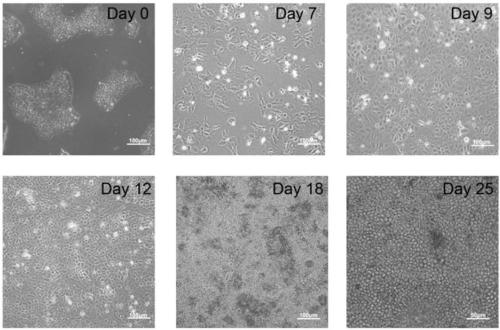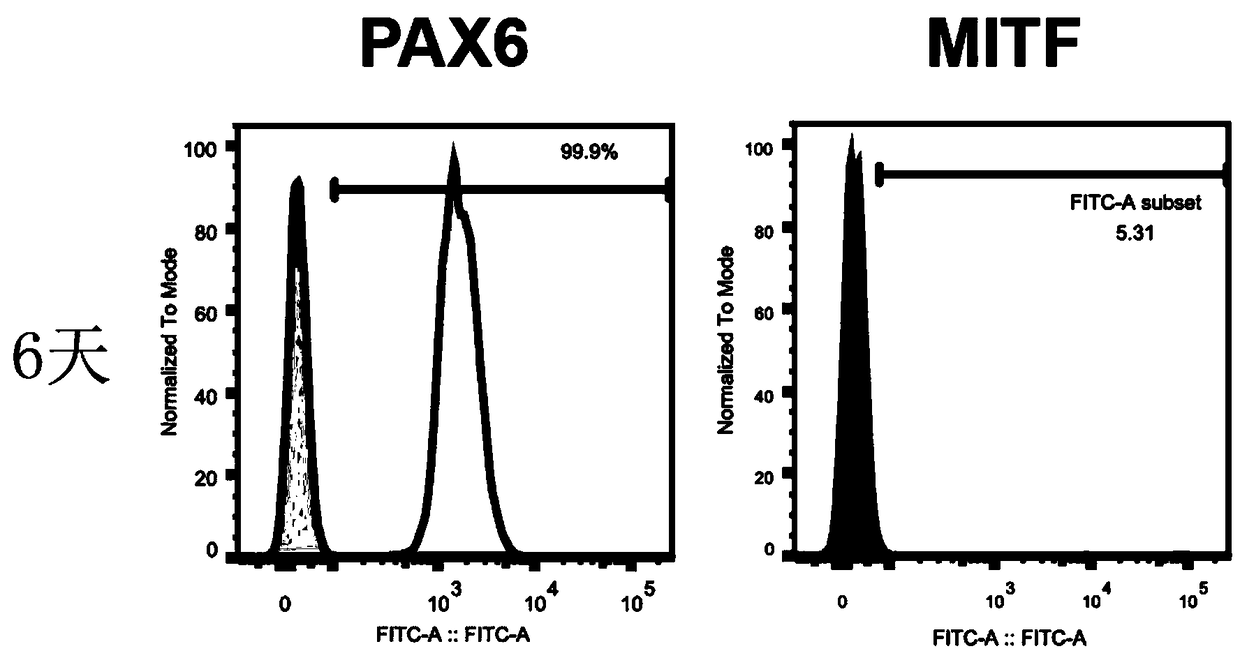Method for inducing human pluripotent stem cell to differentiate into RPE cell
A pluripotent stem cell and cell technology, applied in the field of inducing human pluripotent stem cells to differentiate into RPE cells, can solve the problems of low cell viability and poor treatment effect, and achieve the effect of improving the differentiation efficiency and shortening the differentiation cycle.
- Summary
- Abstract
- Description
- Claims
- Application Information
AI Technical Summary
Problems solved by technology
Method used
Image
Examples
Embodiment 1
[0059] Component media induce human pluripotent stem cells to differentiate into RPE cells.
[0060] 1. Neuroepithelial induction: After passage of hPSCs to Matrigel-coated culture dishes, wait for 30 minutes to 1 hour for adherent growth, and then use the component medium supplemented with 2 μM / mL SB431542 and 2 μM / mL DMH1 to culture, and replace the culture every day base. After 6 days in culture, the cells grew to confluence. The fused neural precursor cells were digested and passaged with Accutase, cultured in a component medium supplemented with 50ng / mL Shh, 10ng / mL IGF1, and 20ng / mL EGF, and the medium was replaced every day. After 3-4 days the cells became confluent and were neuroepithelial.
[0061] 2. Optic neuroepithelial induction: After the neuroepithelium is formed, use the component culture medium supplemented with 50ng / mL Shh, 10ng / mL IGF1, 20ng / mL EGF, 10μg / mL Activin A and 2μM / mL Chir99021.
[0062] 3. Naive RPE differentiation: Induce the optic neuroepithe...
Embodiment 2
[0066] Detection of differentiation efficiency during induction of hPSC differentiation into RPE
[0067] 1. Cell fixation: After digesting the cells in the cell culture dish with Accutase enzyme, blow gently with 2mL PBS, transfer to a 15mL centrifuge tube, and centrifuge at 1500rpm for 3 minutes; remove the supernatant after centrifugation, add 1mL 4% paraformaldehyde to weight Hang and fix for 5 minutes.
[0068] 2. Specific antibody labeling: fixed cells were permeabilized with 0.1% TritonX-100 for 10 minutes, centrifuged at 1500rpm for 3 minutes; rinsed with PBS once for 5 minutes; continued centrifuged at 1500rpm for 3 minutes, added 3% BSA to resuspend gently by pipetting, room temperature Incubate for 1 hour; centrifuge at 1500rpm for 3 minutes, add primary antibody diluted with 3% BSA, incubate at room temperature for 1 hour, add IgG with the same antibody concentration as the negative control; centrifuge at 1500rpm for 3 minutes, add 1mL PBS to rinse 3 times, each ti...
Embodiment 3
[0072] Identification of neuroepithelium, optic neuroepithelium, and naive RPE during induction
[0073] 1. Cell sample collection: On the 0th day and the 6th day of differentiation, pass the differentiated cells to the cell slide, induce differentiation according to the steps in Example 1, and on the 3rd day, 6th day, 9th day, 15th day, 18th day Cells were collected, rinsed twice with PBS to remove dead cells, and fixed by adding 4% paraformaldehyde for 5 minutes.
[0074] 2. Permeabilization and sealing: The fixed cells were permeabilized with 0.1% Triton X-100 for 5 minutes, rinsed twice with PBS, 5 minutes each time; added 3% bovine serum albumin to seal at room temperature for 1 hour;
[0075] 3. Antibody staining: Remove the blocking solution, add the primary antibody diluted with 3% bovine serum albumin, incubate overnight at 4°C; remove the primary antibody, rinse with PBS for 3 times, 5 minutes each time; add diluted with 3% BSA fluorescent secondary antibody, incubate...
PUM
 Login to View More
Login to View More Abstract
Description
Claims
Application Information
 Login to View More
Login to View More - R&D
- Intellectual Property
- Life Sciences
- Materials
- Tech Scout
- Unparalleled Data Quality
- Higher Quality Content
- 60% Fewer Hallucinations
Browse by: Latest US Patents, China's latest patents, Technical Efficacy Thesaurus, Application Domain, Technology Topic, Popular Technical Reports.
© 2025 PatSnap. All rights reserved.Legal|Privacy policy|Modern Slavery Act Transparency Statement|Sitemap|About US| Contact US: help@patsnap.com



